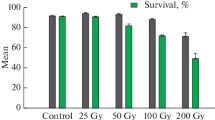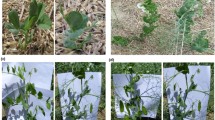Abstract
Global demand for grain legumes including black gram had increased tremendously in the recent past due to their high nutritional value especially in countries with soaring population growth. This necessitates the induction of genetic variation for continued supply of better yielding and improved varieties to the producers keeping in view the rapidly changing agroclimatic condition. In this study, the induced mutant populations of widely recommended T-9 and Pant U-30 varieties of urdbean were generated using single and combination treatments of gamma rays and ethyl methane sulfonate (EMS). Investigation on induced phenotypic variations in individual plants of M2 population of different treatments resulted in identification and isolation of sixteen morphological mutant types affecting plant height, growth habit, leaf morphology, growth period, pod and seed. Frequency of morphological mutants was the highest in combined treatments of gamma rays and EMS followed by individual treatments of EMS and gamma rays. The spectrum of such mutant types was relatively wide in var. Pant U-30 as compared to the var. T-9. Mutants with altered plant height and pod numbers were of maximum occurrence in both the varieties. The mutants with increased pod number and size were found to be significantly correlated with the improved plant yield, thus selected directly for quantitative investigation in subsequent generations.







Similar content being viewed by others
References
Abraham B, Vanaja M, Reddy PRR, Sunil NSN, Kamala V, Varaprasad KS (2013) Identification of stable and high yielding genotypes in black gram [Vigna mungo (L.) Hepper] germplasm. Indian J Genet 73:264–269
Annual Report (2016–2017) In: Government of India, Ministry of Agriculture and Farmers Welfare, Department of Agriculture, Cooperation and Farmers Welfare, Directorate of Pulses Development, Vindhyachal Bhavan, India. http://dpd.gov.in/Web%20Annual%20Report%202016-17%20-pdf. Accessed 25 Aug 2018
Blixt S (1972) Mutation genetics in Pisum. Agric Hort Genet 31:1–293
Gaur PM, Gaur VK, Srinivasan S (2008) An induced brachytic mutant of chickpea and its possible use in ideotype breeding. Euphytica 159:35–41
Gautam AS, Sood KC, Richaria AK (1992) Mutagenic effectiveness and efficiency of gamma rays, ethylmethane sulphonate and their synergistic effects in black gram (Vigna mungo L.). Cytologia 57:85–89
Gottschalk W, Wolff G (1983) Induced mutations in plant breeding. Springer-Verlag, Berlin, Heidelberg, New York
Goyal S, Khan S (2010) Cytology of induced morphological mutants in Vigna mungo (L.) Hepper. Egypt J Biol 12:81–85
Gunkel JE, Sparrow AH (1961) Ionizing radiations: biochemical, physiological and morphological aspects of their effect on plants. In: Ruhland W (ed) Encyclopedia of plant physiology, vol 16. Springer, Berlin, pp 555–611
Jain HK (1975) Breeding for yield and other attributes in grain legumes. Indian J Genet 35:169–187
Jana MK (1963) X-ray induced tall mutants of black gram (Phaseolus mungo L.). Curr Sci 32(10):469–470
Khan S, Wani MR, Bhat MD, Parveen K (2004) Induction of morphological mutants in chickpea. Int Chickpea Pigeonpea Newslett 11:6–7
Konzak CF, Woo SC, Dickey J (1969) An induced semi-dwarf plant height mutation in spring wheat. Wheat Inf Serv 28:10–12
Kouser M, Babu GS, Lavanya GR (2007) Effects of mutagen on M1 population in urdbean. J Food Legum 20(1):109–110
Kumar V, Sharma AK, Singh VP, Kumar M (2009) Characterization of pre-breeding genetic stocks of urdbean (Vigna mungo (L.) Hepper) induced through mutagenesis. In: Shu QY (ed) Induced plant mutations in the genomics era. Food and Agriculture Organization of the United Nation, Rome, pp 391–394
Lather VS (2000) Promising chickpea ideotype for higher plant density. Int Chickpea Pigeonpea Newslett 7:26–27
Marghitu V (1972) Mutagenic effect of X-rays and EMS in French bean in M3 and M4 generations. Striinte Agricole 3:105–109
Nilan RA (1967) Nature of induced mutations in higher plants. Induced mutations and their utilization. In: Proceedings of Symposium Erawim Baur Gedachtnis Orle Singen IV. Acverlag Berlin, pp 5–20
Pawar SE, Manjaya JG, Souframanien J, Bhatia CR (2000) Genetic improvement of pulse crops: induced mutations and their use in cross breeding. In: Proceedings FAO/IAEA workshop on the use of nuclear and molecular techniques in crop improvement. BARC, Mumbai, pp 170–174
Qin R, Qiu Y, Cheng Z, Shan X, Guo X, Zhai H, Wan J (2008) Genetic analysis of a novel dominant rice dwarf mutant 986083D. Euphytica 160:379–387
Rai KN, Hanna WW (1990) Morphological characteristics of tall and dwarf pearl millet isolines. Crop Sci 30:23–25
Ramya B, Nallathambi G (2014) Effect of mutagenesis on germination, survival, pollen and seed sterility in M1 generation of black gram (Vigna mungo (L) Hepper). Plant Arch 14(1):499–501
Reddy VRK, Gupta PK (1988) Induced mutations in hexaploid triticale. Frequency and spectrum of morphological mutants. Genet Agr 42:241–254
Satyanarayana A, Rao Y, Seenaiah P, Kodandaramaiah D (1989) Multifoliate leaf mutants of mungbean and urdbean. Mut Breed Newslett 33:17
Sethi GS (1974) Long-penduncled mutant: a new mutant type induced in barley. Euphytica 23:237–239
Shah TM, Mirza JI, Haq MA, Atta BM (2008) Induced genetic variability in chickpea (Cicer arietinum L.). II. Comparative mutagenic effectiveness and efficiency of physical and chemical mutagens. Pak J Bot 40(2):605–613
Shakoor A, Sadiq MS, Hasan MU, Saleem M (1978) Selection for useful semi dwarf mutants through induced mutation in bread wheat. In: Proceedings of 5th International Wheat Genetic Symposium, New Delhi, Vol. I (23–28), pp 540–546
Sharma SK, Sharma B (1979) Leaf mutations induced with NMU and gamma rays in lentil (Lens culinaris Medik). Curr Sci 48:916–917
Sharma SK, Sood R, Pandey DP (2005) Studies on mutagen sensitivity, effectiveness and efficiency in urdbean (Vigna mungo (L.) Hepper). Indian J Genet 65:20–22
Sidorova KK (1981) Influence of genotypic background on the expressivity of mutant genes of pea. Pulse Crops Newslett 1(3):23–24
Singh RK (1996) Gamma ray induced bold seeded mutant in Vigna mungo (L.) Hepper. Indian J Genet 56(1):104–108
Singh VP, Singh M, Pal JP (1999) Mutagenic effects of gamma rays and EMS on frequency and spectrum of chlorophyll and macromutations in urdbean (Vigna mungo (L.) Hepper). Indian J Genet 59(2):203–210
Solanki IS, Sharma B (1999) Induction and isolation of morphological mutations in different damage groups in lentil (Lens culinaris Medik). Indian J Genet 59(4):479–485
Solanki IS, Phogat DS, Waldia RS (2004) Frequency and spectrum of morphological mutations and effectiveness and efficiency of chemical mutagens in macrosperma lentil. Natl J Plant Improv 6(1):22–25
Talukdar D (2009) Dwarf mutations in grass pea (Lathyrus sativus L.): Origin, morphology, inheritance and linkage studies. J Genet 88(2):165–175
Talukdar D, Biswas AK (2006) An induced internode mutant in grass pea. In: Das RK, Chatterjee S, Sadhukhan GC (eds) Perspectives in cytology and genetics, vol 12. AICCG Pub, Kalyani, pp 267–271
Thakur HL, Sethi GS (1993) Characterization and segregation pattern of some macromutations induced in black gram (Vigna mungo (L.) Hepper). Indian J Genet 53(2):168–173
Toker C, Cagirgan MI (2004) Spectrum and frequency of induced mutations in chickpea. Int Chickpea Pigeonpea Newslett 11:8–10
Tyagi BS, Gupta PK (1991) Induced macromutations in lentil. Lens 18:3–7
Usharani KS, Kumar CRA (2015) Induced viable mutants in urdbean (Vigna mungo (L.) Hepper). Bioscan 10(3):1103–1108
Verma SNP (1969) Inheritance of some qualitative characters in green gram (Phaseolus aureus Roxb.). Indian J Hered 1:105–106
Acknowledgements
The authors are thankful to the University Grants Commission (UGC) New Delhi, India, for providing financial assistance and Aligarh Muslim Uiversity, Aligarh, India for lending infrastructural facilities.
Author information
Authors and Affiliations
Corresponding author
Ethics declarations
Conflict of interest
The authors declare that there is no conflict of interest regarding the publication of this article.
Additional information
Publisher's Note
Springer Nature remains neutral with regard to jurisdictional claims in published maps and institutional affiliations.
Rights and permissions
About this article
Cite this article
Goyal, S., Wani, M.R., Laskar, R.A. et al. Induction of morphological mutations and mutant phenotyping in black gram [Vigna mungo (L.) Hepper] using gamma rays and EMS. Vegetos 32, 464–472 (2019). https://doi.org/10.1007/s42535-019-00057-w
Received:
Revised:
Accepted:
Published:
Issue Date:
DOI: https://doi.org/10.1007/s42535-019-00057-w




